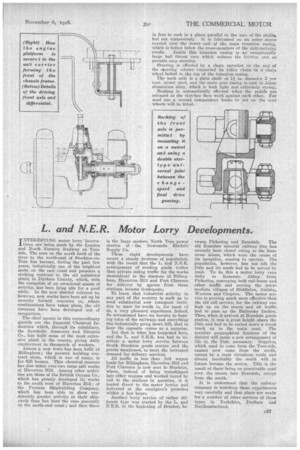L. and N.E.R. Motor Lorry Developments.
Page 21

If you've noticed an error in this article please click here to report it so we can fix it.
TNTERESTING motor lorry innova tions are being Made by the London and North Eastern Railway on Teesside. The area on the north bank of the river to the north-east of Stockton-onTees has become, during the past few years, industrially one of the brightest spots on the cast coast and presents striking contrast to the old industrial plant; in Durham County, Which, with the exception of an occasional spasm of activity, has been lying idle for a good while. In the new district referred to, however, new workS have been set up by recently formed concerns or, where combinations have taken place, the old concerns have been developed out a
recognition. • The chief agents in this extraordinary growth are the Imperial Chemical Industries which, through its subsidiary, the Synthetic Ammonia and Nitrates Co., has built some of the most extensive plant in the county, giving daily employment to thousands of workers.
Almost a new town has been built at Dillingham; the present building contract alone, which is one of many, is for 625 houses. This chemical concern has also taken over. two large salt works at Haverton Hill. Among other activities are those of the British Oxygen Co., which has greatly developed its works to the south west of Haverton Hill; of the Furness Shipbuilding Company, which has been able to show consistently greater activity at their shipyards than has been the case generally on the north-east coast ; and then there is the large modern North Tees power station of • the Newcastle Electric Supply Co.
These rapid developments have meant a steady increase of population, with the result that the L. and N.E.R. arrangement of sending goods (other than private siding traffic for the works themselves) to the stations at Dillingham, Haverton Hill and Port Clarence for delivery by agents from those stations, became inadequate.
To learn that industrial activity in any part of the country is such as to need substantial new transport facilities to meet its needs is, for most cf us, a very pleasant experience indeed. So accustomed have we become to hearing tales of the railways and everything else industrially going down hill, that to hear the opposite comes as a surprise.
Yet that is what has happened here, and the L. and N.E.R. has had to institute a motor lorry service between South Stockton goods station and the points mentioned, to meet the increased demand for delivery services.
All traffic in less than full wagon loads for Dillingham, Haverton Hill and Port Clarence is now sent to Stockton, where, instead of being transhipped into other wagons and worked round by rail to the stations in question, it is loaded direct to the motor lorries and delivered at the consignee's premises within • a few hours.
Another lorry service of rather different type was started by the L. and N.E.R. at the beginning of October, be
tween Pickering and Rosedale. The old Rosedale mineral railway line has recently been closed owing to the limestone mines, which were the cause of its inception, ceasing to operate. The population, however, has not left the Dale and its needs had to be served by road. To du this a motor lorry runs daily to Rosedale Abbey from Pickering, conveying both rail-borne and other traffic and serving the intermediate villages of Middleton, Aislaby, Wretton and Cropton. The motor service is proving much more effective than the old rail service, for the railway ran high up on the moors and all traffic had to pass up the Battersby Then, when it arrived at Rosedale goods station, it was a great height above the Dale and had to be carted down a rough track on to the main road. The peculiar geographical features of the district will make a new arrangement of life -in the Dale necessary. Supplies, which used to come from the Tees-side, cannot now come from the north, except by a most circuitous route and almost inevitably the south will in future become the source. This is the result of there• being no practicable road over the moors into Rosedale, except from the south.
It is understood that the railway company is watching these experiments very carefully and that plans are ready for a number of other services of these types in Yorkshire, Durham and Northumberland.






























